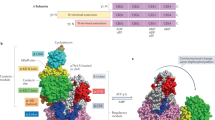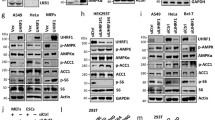Abstract
Aim:
To discover the active compound on AMP-activated protein kinase (AMPK) activation and investigate the effects of the active compound 1,8-dihydroxyanthraquinone (danthron) from the traditional Chinese medicine rhubarb on AMPK-mediated lipid and glucose metabolism in vitro.
Methods:
HepG2 and C2C12 cells were used. Cell viability was determined using MTT assay. Real-time PCR was performed to measure the gene expression. Western blotting assay was applied to investigate the protein phosphorylation level. Enzymatic assay kits were used to detect the total cholesterol (TC), triglyceride (TG) and glucose contents.
Results:
Danthron (0.1, 1, and 10 μmol/L) dose-dependently promoted the phosphorylation of AMPK and acetyl-CoA carboxylase (ACC) in both HepG2 and C2C12 cells. Meanwhile, danthron treatment significantly reduced the lipid synthesis related sterol regulatory element-binding protein 1c (SREBP1c) and fatty acid synthetase (FAS) gene expressions, and the TC and TG levels. In addition, danthron treatment efficiently increased glucose consumption. The actions of danthron on lipid and glucose metabolism were abolished or reversed by co-treatment with the AMPK inhibitor compound C.
Conclusion:
Danthron effectively reduces intracellular lipid contents and enhanced glucose consumption in vitro via activation of AMPK signaling pathway.
Similar content being viewed by others
Log in or create a free account to read this content
Gain free access to this article, as well as selected content from this journal and more on nature.com
or
References
DeFronzo RA, Ferrannini E . Insulin resistance. A multifaceted syndrome responsible for NIDDM, obesity, hypertension, dyslipidemia, and atherosclerotic cardiovascular disease. Diabetes Care 1991; 14: 173–94.
Grundy SM . Obesity, metabolic syndrome, and cardiovascular disease. J Clin Endocrinol Metab 2004; 89: 2595–600.
Kahn BB, Alquier T, Carling D, Hardie DG . AMP-activated protein kinase: ancient energy gauge provides clues to modern understanding of metabolism. Cell Metab 2005; 1: 15–25.
Zhang BB, Zhou G, Li C . AMPK: an emerging drug target for diabetes and the metabolic syndrome. Cell Metab 2009; 9: 407–16.
Yu LF, Qiu BY, Nan FJ, Li J . AMPK activators as novel therapeutics for type 2 diabetes. Curr Top Med Chem 2010; 10: 397–410.
Hawley SA, Davison M, Woods A, Davies SP, Beri RK, Carling D, et al. Characterization of the AMP-activated protein kinase kinase from rat liver and identification of threonine 172 as the major site at which it phosphorylates AMP-activated protein kinase. J Biol Chem 1996; 271: 27879–87.
Luo Z, Saha AK, Xiang X, Ruderman NB . AMPK, the metabolic syndrome and cancer. Trends Pharmacol Sci 2005; 26: 69–76.
Im SS, Kwon SK, Kim TH, Kim HI, Ahn YH . Regulation of glucose transporter type 4 isoform gene expression in muscle and adipocytes. IUBMB Life 2007; 59: 134–45.
Horike N, Sakoda H, Kushiyama A, Ono H, Fujishiro M, Kamata H, et al. AMP-activated protein kinase activation increases phosphorylation of glycogen synthase kinase 3beta and thereby reduces cAMP-responsive element transcriptional activity and phosphoenolpyruvate carboxykinase C gene expression in the liver. J Biol Chem 2008; 283: 33902–10.
Cool B, Zinker B, Chiou W, Kifle L, Cao N, Perham M, et al. Identification and characterization of a small molecule AMPK activator that treats key components of type 2 diabetes and the metabolic syndrome. Cell Metab 2006; 3: 403–16.
Corton JM, Gillespie JG, Hawley SA, Hardie DG . 5-aminoimidazole-4-carboxamide ribonucleoside. A specific method for activating AMP-activated protein kinase in intact cells? FEBS J 1995; 229: 558–65.
Walker J, Jijon HB, Diaz H, Salehi P, Churchill T, Madsen KL . 5-aminoimidazole-4-carboxamide riboside (AICAR) enhances GLUT2-dependent jejunal glucose transport: a possible role for AMPK. Biochem J 2005; 385: 485–91.
Zang M, Zuccollo A, Hou X, Nagata D, Walsh K, Herscovitz H, et al. AMP-activated protein kinase is required for the lipid-lowering effect of metformin in insulin-resistant human HepG2 cells. J Biol Chem 2004; 279: 47898–905.
Lee YS, Kim WS, Kim KH, Yoon MJ, Cho HJ, Shen Y, et al. Berberine, a natural plant product, activates AMP-activated protein kinase with beneficial metabolic effects in diabetic and insulin-resistant states. Diabetes 2006; 55: 2256–64.
Lu Y, Yang JH, Li X, Hwangbo K, Hwang SL, Taketomi Y, et al. Emodin, a naturally occurring anthraquinone derivative, suppresses IgE-mediated anaphylactic reaction and mast cell activation. Biochem Pharmacol 2011; 82: 1700–8.
Niu Y, Li S, Na L, Feng R, Liu L, Li Y, et al. Mangiferin decreases plasma free fatty acids through promoting its catabolism in liver by activation of AMPK. PLoS One 2012; 7: e 30782.
Liu J, Zhang JF, Lu JZ, Zhang DL, Li K, Su K, et al. Astragalus polysaccharide stimulates glucose uptake in L6 myotubes through AMPK activation and AS160/TBC1D4 phosphorylation. Acta Pharmacol Sin 2013; 34: 137–45.
Toyoda K, Nishikawa A, Furukawa F, Kawanishi T, Hayashi Y, Takahashi M . Cell proliferation induced by laxatives and related compounds in the rat intestine. Cancer Lett 1994; 83: 43–9.
Lu HF, Lai TY, Hsia TC, Tang YJ, Yang JS, Chiang JH, et al. Danthron induces DNA damage and inhibits DNA repair gene expressions in GBM 8401 human brain glioblastoma multiforms cells. Neurochem Res 2010; 35: 1105–10.
Rossi S, Tabolacci C, Lentini A, Provenzano B, Carlomosti F, Frezzotti S, et al. Anthraquinones danthron and quinizarin exert antiproliferative and antimetastatic activity on murine B16-F10 melanoma cells. Anticancer Res 2010; 30: 445–9.
Zhang H, Zhou R, Li L, Chen J, Chen L, Li C, et al. Danthron functions as a retinoic X receptor antagonist by stabilizing tetramers of the receptor. J Biol Chem 2011; 286: 1868–75.
Mantena SK, Sharma SD, Katiyar SK . Berberine inhibits growth, induces G1 arrest and apoptosis in human epidermoid carcinoma A431 cells by regulating Cdki-Cdk-cyclin cascade, disruption of mitochondrial membrane potential and cleavage of caspase 3 and PARP. Carcinogenesis 2006; 27: 2018–27.
Huang H, Yu Y, Gao Z, Zhang Y, Li C, Xu X, et al. Discovery and optimization of 1,3,4-trisubstituted-pyrazolone derivatives as novel, potent, and nonsteroidal farnesoid X receptor (FXR) selective antagonists. J Med Chem 2012; 55: 7037–53.
Chignell CF . The effect of phenolphthalein and other purgative drugs on rat intestinal (Na++K+) adenosine triphosphatase. Biochem Pharmacol 1968; 17: 1207–12.
Genvigir FD, Rodrigues AC, Cerda A, Arazi SS, Willrich MA, Oliveira R, et al. Effects of lipid–lowering drugs on reverse cholesterol transport gene expressions in peripheral blood mononuclear and HepG2 cells. Pharmacogenomics 2010; 11: 1235–46.
Kase ET, Thoresen GH, Westerlund S, Hojlund K, Rustan AC, Gaster M . Liver X receptor antagonist reduces lipid formation and increases glucose metabolism in myotubes from lean, obese and type 2 diabetic individuals. Diabetologia 2007; 50: 2171–80.
Oram JF, Vaughan AM . ATP-Binding cassette cholesterol transporters and cardiovascular disease. Circ Res 2006; 99: 1031–43.
Li D, Zhang Y, Ma J, Ling W, Xia M . Adenosine monophosphate activated protein kinase regulates ABCG1-mediated oxysterol efflux from endothelial cells and protects against hypercholesterolemia–induced endothelial dysfunction. Arterioscler Thromb Vasc Biol 2010; 30: 1354–62.
Uehara Y, Miura S, von Eckardstein A, Abe S, Fujii A, Matsuo Y, et al. Unsaturated fatty acids suppress the expression of the ATP-binding cassette transporter G1 (ABCG1) and ABCA1 genes via an LXR/RXR responsive element. Atherosclerosis 2007; 191: 11–21.
Field FJ, Born E, Mathur SN . LXR/RXR ligand activation enhances basolateral efflux of beta-sitosterol in CaCo-2 cells. J Lipid Res 2004; 45: 905–13.
Murthy S, Born E, Mathur SN, Field FJ . LXR/RXR activation enhances basolateral efflux of cholesterol in CaCo-2 cells. J Lipid Res 2002; 43: 1054–64.
Klip A, Schertzer JD, Bilan PJ, Thong F, Antonescu C . Regulation of glucose transporter 4 traffic by energy deprivation from mitochondrial compromise. Acta Physiol (Oxf) 2009; 196: 27–35.
Chen Z, Zhang L, Yi J, Yang Z, Zhang Z, Li Z . Promotion of adiponectin multimerization by emodin: a novel AMPK activator with PPARgamma-agonist activity. J Cell Biochem 2012; 113: 3547–58.
Acknowledgements
This work was supported by the National Science and Technology Major Project (grants 2012ZX09301001-004 and 2012ZX09103101-18), the National Natural Science Foundation of China (grants 81173105 and 91213306), the Foundation of Chinese Academy of Sciences (grant KSCX2-EW-Q-3), the National Marine 863 Programme (grant 2011AA09070102) and the Science Foundation of Shanghai (grant 11XD1406100).
Author information
Authors and Affiliations
Corresponding authors
Rights and permissions
About this article
Cite this article
Zhou, R., Wang, L., Xu, X. et al. Danthron activates AMP-activated protein kinase and regulates lipid and glucose metabolism in vitro. Acta Pharmacol Sin 34, 1061–1069 (2013). https://doi.org/10.1038/aps.2013.39
Received:
Accepted:
Published:
Issue date:
DOI: https://doi.org/10.1038/aps.2013.39
Keywords
This article is cited by
-
The regulation of Niemann-Pick C1-Like 1 (NPC1L1) gene expression in opposite direction by Bacteroides spp. and related outer membrane vesicles in Caco-2 cell line
Journal of Diabetes & Metabolic Disorders (2020)
-
Identification of danthron as an isoform-specific inhibitor of HEME OXYGENASE-1/cytochrome P450 reductase interaction with anti-tumor activity
Journal of Biomedical Science (2018)
-
MG132, a proteasome inhibitor, enhances LDL uptake in HepG2 cells in vitro by regulating LDLR and PCSK9 expression
Acta Pharmacologica Sinica (2014)
-
Probucol suppresses human glioma cell proliferation in vitro via ROS production and LKB1-AMPK activation
Acta Pharmacologica Sinica (2014)



